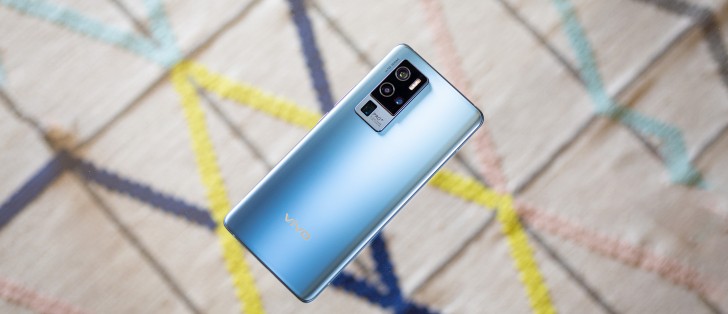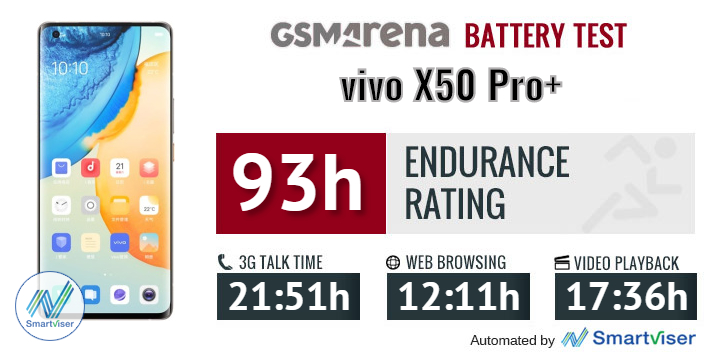vivo X50 Pro+ review

Superb AMOLED screen
The vivo X50 Pro+ packs a 6.56" AMOLED screen with extended 1080p resolution and rounded edges, and there is a tiny punch-hole to accommodate the selfie camera.
The screen resolution is 2,376 x 1,080 pixels making for sharp 398ppi density. The panel is covered with curved tempered glass, and additionally, vivo is shipping the phone with a very thin protective film pre-applied at the factory.

The vivo X50 Pro+ screen supports 120Hz high refresh rate. You can choose between 60Hz, 120Hz, or Smart Switch based on content.
The OLED screen supports HDR10+ and is recognized by all popular apps as such. Unfortunately, at this stage, the X50 Pro+ supports the basic Widevine L3 DRM, meaning the popular streaming apps will serve SD content only.
We did some brightness measurements and we found that X50 Pro+ panel to be quite bright for an OLED. Using the brightness scrubber, we got a maximum brightness of 500 nits. When the screen uses Adaptive Brightness, it can light up as high as 733nits - a great performance, indeed.
Finally, the minimum brightness we were able to achieve with white was 2.2 nits - so an excellent result.
| Display test | 100% brightness | ||
| Black, |
White, |
||
| 0 | 499 | ∞ | |
| 0 | 733 | ∞ | |
| 0 | 489 | ∞ | |
| 0 | 503 | ∞ | |
| 0 | 498 | ∞ | |
| 0 | 811 | ∞ | |
| 0 | 510 | ∞ | |
| 0 | 858 | ∞ | |
| 0 | 538 | ∞ | |
| 0 | 888 | ∞ | |
| 0 | 496 | ∞ | |
| 0 | 803 | ∞ | |
| 0 | 425 | ∞ | |
| 0 | 531 | ∞ | |
| 0 | 455 | ∞ | |
| 0 | 760 | ∞ | |
| 0 | 504 | ∞ | |
| 0 | 1024 | ∞ | |
| 0 | 398 | ∞ | |
| 0 | 894 | ∞ | |
| 0 | 536 | ∞ | |
| 0 | 871 | ∞ | |
The vivo X50 Pro+ display supports DCI-P3 and sRGB color spaces. You get to choose between Standard, Normal, or Bright color modes. In each of these, you will get a color temperature slider going from cool to warm.
The default Standard mode got us an average DeltaE of 3.9 against DCI-P3 targets. If you move the temperature slider midway to Warm, you can get rid of the blue tinge of the white and gray hues and get higher color accuracy with an average DeltaE of 2.2 or so.
The Bright Mode is pretty much the same as the Standard, with more saturated red and green hues.
With Normal mode, we measured an average DeltaE of 1.7 against sRGB targets.
Overall, color reproduction is very good on the X50 Pro+, and it can be even excellent if that's what you are after.
Battery life and charging
The vivo X50 Pro+ is powered by a 4,350 mAh battery. The phone supports 44W fast charging, faster than 33W's on the X50 Pro. The X50 Pro+ ships with an even faster 55W charger - it gets the battery from flat to 60% in 30 mins and to 100% in 70 mins.
The X50 Pro+ clocked great Screen-On-Times on our battery tests - it can last more than 12 hours in web browsing, while you can watch movies for nearly 18 hours.
The standby performance turned out to be about the average for a 4,300 mAh battery, and everything combined resulted in the very good endurance rating of 93 hours.

Our battery tests were automated thanks to SmartViser, using its viSer App. The endurance rating above denotes how long a single battery charge will last you if you use the vivo X50 Pro+ for an hour each of telephony, web browsing, and video playback daily. We've established this usage pattern so that our battery results are comparable across devices in the most common day-to-day tasks. The battery testing procedure is described in detail in case you're interested in the nitty-gritty. You can check out our complete battery test table, where you can see how all of the smartphones we've tested will compare under your own typical use.
Speaker test
The vivo X50 Pro+ is equipped with a single loudspeaker on the bottom.
In terms of loudness, the vivo X50 Pro+ scored a 'Good' mark. However, the good news ends here. The speaker is of poor quality, and it's lacking in both the low and high ends, while the presentation of the mid tone is all over the place.
Use the Playback controls to listen to the phone sample recordings (best use headphones). We measure the average loudness of the speakers in LUFS. A lower absolute value means a louder sound. A look at the frequency response chart will tell you how far off the ideal "0db" flat line is the reproduction of the bass, treble, and mid frequencies. You can add more phones to compare how they differ. The scores and ratings are not comparable with our older loudspeaker test. Learn more about how we test here.
Audio output quality
We've recently discontinued our audio output quality test.
The reason for that is that most phones that arrived for testing were already excellent in this regard. Whatever difference there was, it was marginal and probably indistinguishable to anything but our lab equipment.
Reader comments
- Anonymous
- 05 Mar 2021
- gBV
I think it could be maybe indeed possible to achieve a slightly(!) higher resolution with Quad Bayer dual pixel sensors than with Quad Bayer sensors (by using a super resolution algorithm), but it seems that Vivo doesn't do that.
- Anonymous
- 19 Feb 2021
- gBV
Samsung, you promised that the GN1 sensor can take 100 megapixel photos, so just a marketing lie?Samsung said "Samsung also provides a software algorithm that takes light information from each photodiode to produce image resolutions comparable t...
- aquinoe
- 04 Feb 2021
- 0p}
Hi. Great camera... but I'm still curious if you can improve photo quality using a Gcam port, specially on ultrawide and telephoto. Has anyone been able to found such a multicamera conscious Gcam?